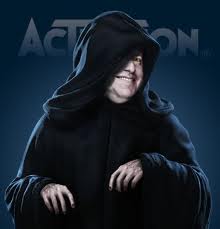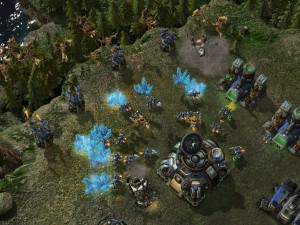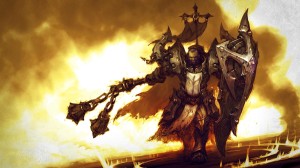The first thing that often comes to mind when the name Blizzard Entertainment is evoked is the high quality games of Warcraft, StarCraft, and Diablo. This is true, however, since the early days of LAN parties with the first iterations of StarCraft and the baby steps of Battle.net with Warcraft II, there was enough to satisfy fans of both the gameplay and the story.
As rudimentary as they were, the stories of Diablo, Warcraft, and StarCraft, were handled well enough for the time. Using computers with limited processing capability, it forced the developers to use a minimalist approach to how they chose the story to progress. In Diablo, it was the scrolling text voice overs of the townsfolk, it was the talking heads of the characters between story beats in StarCraft, and in Warcraft II, it was the introductory mission briefing of each level.
And it worked.
The payoff for each game was a prerendered computer generated sequence that was a marvel for the time. Seeing the hero sacrifice himself to seal Diablo in his body to contain the Lord of Terror, the triumph of Tassadar over the Overmind on Auir, and witnessing Khadgar sealing the Dark Portal for good was exhilarating. It would be one of Blizzard’s best traits going forward. They knew how to make a game pay off upon success.
Unfortunately, it was also a trend that would also carry some serious detriments as well.
Blizzard was a game company whose successes had proved to those that waited for their games that it would be worth the wait. The old adage ‘it will be done when it is done’ was the mantra Blizzard often used to explain their games often being delayed. And, without fail, the game would sell millions of copies, as evidenced by Diablo II selling over four million copies back in 2000.
All seemed to be going well for Blizzard, however, in December of 2007, Blizzard merged with Activision and the atmosphere seemed to change, despite vehement denial by the staff that had the bravery to interact with the playerbase.
With the expanded budget, it gave the the creative development team, led by Chris Metzen, to allow their imaginations to run wild with things they were never able to do when Blizzard was its own entity.
It definitely assisted Blizzard with its recently released World of Warcraft MMO, as it had a much larger budget to work with and with WoW maintaining a lead that most companies would only dream of, Chris Metzen allowed the success to cloud his memory to the times when he was limited to the tiny budgets they were allowed back in the 90s.
The story-telling started to suffer with more recent releases due to a myriad of factors, between incompetence, lack of ‘time’ or interest, and more; World of Warcraft: Cataclysm was the first of many cracks in Blizzard’s writing.
The expansion showcased Deathwing the Destroyer, a gargantuan dragon of immense strength and power, tearing the world asunder and being a catalyst for reigniting the already unstable relations between the Alliance and the Horde, now led by the son of warmonger Grom (of Warcraft III fame), Garrosh Hellscream.
In proper context, it was a waste of storytelling material. Deathwing, back in the earlier lexicon of Warcraft history, often disguised himself as a human to sew discord between the human kingdoms and used subtlety and cunning to execute his plans. In Cataclysm, he was reduced to a boss that the player never interacted with until the final raid tier. Contrast this with the Lich King of the previous expansion, whom the player already knew the story, either through Warcraft III or through the various factions that served him throughout the game’s life. The player knew whom Arthas was and what he wanted to do. The Lich King was a foe to be feared. Deathwing, was just a big, stupid lizard that occasionally set fire to the zone and the player obtained an achievement for ‘stepping into the fire’ and dying.
In addition, the revised leveling content, attempting to emphasize the war between the factions, was a lopsided mess. The leveling experience of the Forsaken playable race was a string of victories handed to the Horde on a silver platter due to Dave Kosak’s unsubtle boner for undead elves, where as the supposedly honorable Kalimdor Horde could not decide whether they were noble savages or brutal conquerors. The Alliance questing experience was a rushed mess, cutting off formerly accessible zones, cutting the story mid-tale of the newly playable Alliance leaning Worgen race as part of the Forsaken leveling experience, and forced pop culture references ranging from CSI to Rambo in a most intellectually insulting way. The excuse was that the developers had simply run out of time to give the same amount of care to the Alliance story, but there have been doubts as to this claim, as one only needs to go to Blizzcon to hear whom the developers put their passion into.
And in the biggest display of ego of the likes of David Cage can only dream about, Thrall, one of the primary characters of the franchise since Warcraft III, one of the many characters voiced by Chris Metzen, insists that he be called by his true name, Go’el (in an unsubtle reference to Superman) and the story superimposes him as the only one to take down Deathwing. The end result was a slog of a questline in which the player had to go through the many trite and predictably awful parts of his character. It ultimately presents Thrall as nothing more than a self-insert of Chris Metzen with all the tact of a tidal wave, drowning anyone it touches with how awesome he is.
Next, came the much anticipated; StarCraft II. Blizzard was under understandable pressure to ensure this was as good as the first, due to the fact that StarCraft in South Korea is a national sport with star players, nationally televised matches, and scandals involving gambling rings. So, they did.
However, the story did not maintain the same level of quality that its predecessor had. The base game, Wings of Liberty, emphasized flawed hero Jim Raynor, pining for his compatriot/love interest, now infested, mass murdering monster, Kerrigan, Queen of Blades and his attempts to restore her humanity through a macguffin. Which also tied into a prophecy, which is a common occurrence in Blizzard games.
The sequel/expansion suffered all the more, being the Zerg campaign and giving the player control of a now de-infested (defested?) Kerrigan as she rounds up the leaderless Zerg Swarm to obtain her revenge against the Emperor of the Terran Dominion; Arcturus Mengsk, murdering innocent and guilty alike in the millions, if not billions, in vain attempts to make the player sympathize with her. This is emphasized as Kerrigan brutally slaughters a group of Protoss colonists, attempting to terraform an ice bound world, and she uses a captured Protoss to murder the rest of her compatriots in a manner that was excessive, even for a setting such as StarCraft.
Finally; in Diablo III, the player is introduced to a new character, Leah, the niece of Diablo story veteran, Deckard Cain. During the game, she recounts her and Deckard’s adventures through the world of Sanctuary. Leah actually becomes the most sympathetic character in the Diablo universe when she tells about her hopes of opening an inn to provide a safe place for travelers in a world as unforgiving as Sanctuary.
Unfortunately, the story takes a mercilessly dark turn as Leah is set up to be the reincarnation of Diablo himself… or herself, as the model appears to have been redesigned, in the worst possible taste, so that the Lord of Terror appears more feminine. While it is to be expected that the Diablo story was not meant to be all flowers, kittens, and rainbows, (Unless the player goes to Whimseyshire.) it reeks of Blizzard’s attempts of pushing the envelope just for the sake of drama, not for a good story.
Which leads to the conclusion that Chris Metzen and the writing staff at Blizzard are trying too hard, never took the lessons from writing class to heart, or are simply incapable of writing intellectually mature stories. They see the success of George R.R. Martin’s books and foolishly believe that being ‘edgy’, ‘fridging the female’, bigger explosions, and blood for blood’s sake can somehow make up for the lack of character interaction, proper pacing, and actual story development.
Chris Metzen has often stated in interviews that he likes redemption stories, as evidenced in many of Blizzard’s games. He has also admitted that he is a one-trick pony when it comes to writing.
And sadly, it is hard to disbelieve him.




